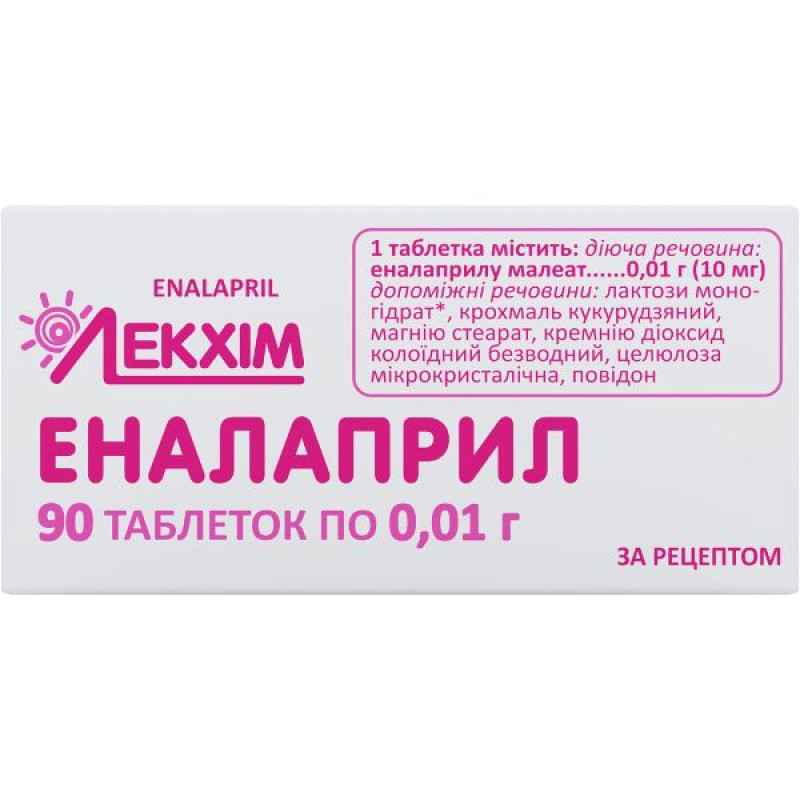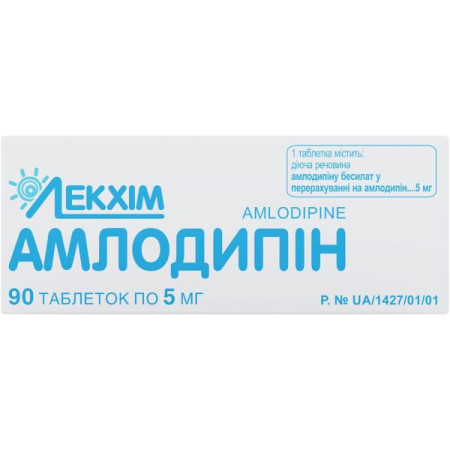Enalapril tablets 0.01 g blister No. 90

Enalapril tablets are used for the following indications:
Treatment of arterial hypertension. Treatment of clinically significant heart failure. Prevention of clinically significant heart failure in patients with asymptomatic left ventricular dysfunction (ejection fraction ≤ 35%).Composition
Active ingredient: enalapril maleate;
1 tablet contains enalapril maleate 0.01 g (10 mg);
Excipients: lactose monohydrate, corn starch, microcrystalline cellulose, magnesium stearate, colloidal anhydrous silicon dioxide, povidone.
Contraindication
Hypersensitivity to enalapril, to any of the excipients or to any other ACE inhibitor. History of angioedema associated with the use of ACE inhibitors. Hereditary or idiopathic angioedema. Enalapril should not be used with drugs containing aliskiren, in patients with diabetes mellitus or with impaired renal function (GFR <60 ml/min/1.73 m2). Pregnant women or women planning to become pregnant. Enalapril should not be taken within 36 hours of switching from/to sacubitril/valsartan, a drug containing a neprilysin inhibitor.Method of application
Food intake does not affect the absorption of Enalapril tablets.
If the drug is prescribed in a dose of less than 5 mg, enalapril preparations with the possibility of such a dosage should be used.
The dosage should be individualized according to each patient's condition and blood pressure response.
Application features
Pregnant women
The drug should not be used by pregnant women or women planning to become pregnant.
Children
Apply to children from 6 years old.
Enalapril is not recommended for use in neonates and children with a glomerular filtration rate <30 mL/min/1.73 m2 due to lack of data.
Drivers
When driving or operating machinery, the possible development of dizziness or fatigue should be taken into account.
Overdose
There is limited data on overdose. The main signs of overdose, according to available data, are pronounced arterial hypotension, which begins approximately 6 hours after administration of the drug and coincides with blockade of the renin-angiotensin system, and stupor. Symptoms associated with overdose with ACE inhibitors may include circulatory shock, electrolyte imbalance, renal failure, hyperventilation of the lungs, tachycardia, palpitations, bradycardia, dizziness, anxiety and cough. Plasma levels of enalaprilat exceeding 100 and 200 times the maximum levels achieved with therapeutic doses have been reported after administration of 300 mg and 440 mg of enalapril, respectively.
For the treatment of overdose, intravenous infusions of isotonic solution are recommended. If hypotension occurs, the patient should be placed in a horizontal position. The need for infusions of angiotensin II and / or intravenous administration of catecholamines may be considered. If the drug has been taken recently, measures to eliminate enalapril maleate (such as artificial vomiting, gastric lavage, the use of absorbents and sodium sulfate) are recommended. Enalaprilat can be removed from the systemic circulation by hemodialysis (see section "Special instructions": patients on hemodialysis). Pacemaker therapy is indicated for bradycardia resistant to therapeutic agents. Vital signs, electrolyte concentrations and serum creatinine levels should be monitored continuously.
Side effects
When using Enalapril, in most cases, side effects were minor, temporary, and did not require discontinuation of therapy.
Blood system: anemia (including aplastic and hemolytic); neutropenia, decreased hemoglobin, decreased hematocrit, thrombocytopenia, agranulocytosis, bone marrow depression, pancytopenia, lymphadenopathy, autoimmune diseases. Endocrine system: syndrome of inappropriate antidiuretic hormone secretion.Metabolic disorders: hypoglycemia (see section "Special warnings and precautions for use").
Nervous system and psyche: depression, headache; confusion, drowsiness, insomnia, nervousness, paresthesia, vertigo; sleep disorders, abnormal dreams. Visual organs: blurred vision.Skin and subcutaneous tissue disorders: rash, hypersensitivity/angioedema of the face, extremities, lips, tongue, glottis and/or larynx (see section "Special warnings and precautions for use"); increased sweating, itching, urticaria, alopecia; erythema multiforme, Stevens-Johnson syndrome, exfoliative dermatitis, toxic epidermal necrolysis, pemphigus, erythroderma.
A complex symptom complex has been reported, including some or all of the following: fever, serositis, vasculitis, myalgia/myositis, arthralgia/arthritis, positive antinuclear antibody test, increased erythrocyte sedimentation rate (ESR), eosinophilia, and leukocytosis. Rash, photosensitivity, and other skin reactions may also occur as side effects. Urinary system: renal dysfunction, renal failure, proteinuria; oliguria. Reproductive system: impotence; gynecomastia. General disorders and administration site conditions: asthenia; fatigue; muscle cramps, hot flashes, tinnitus, malaise, fever.Interaction
Alcohol enhances the hypotensive effect of ACE inhibitors.
Sympathomimetics may reduce the antihypertensive effects of ACE inhibitors.
Storage conditions
Store out of the reach of children in the original packaging at a temperature not exceeding 25 °C.
Shelf life - 3 years.
There are no reviews for this product.
There are no reviews for this product, be the first to leave your review.
No questions about this product, be the first and ask your question.


